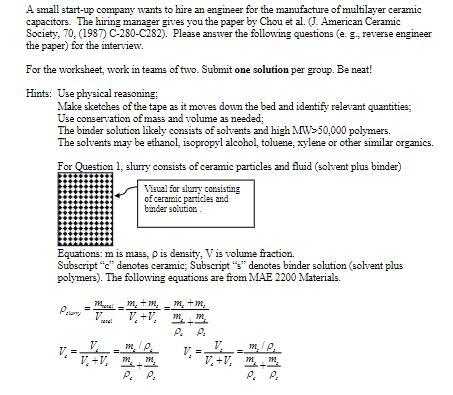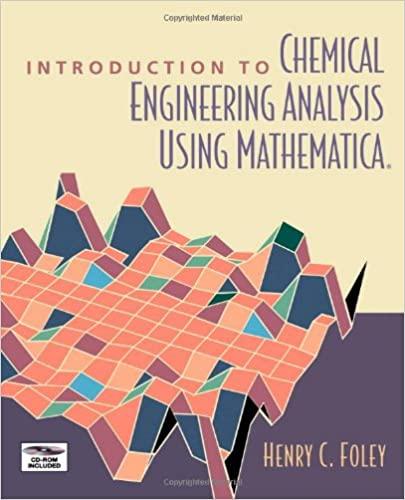

A small start-up company wants to hire an engineer for the manufacture of multilayer ceramic capacitors. The hiring manager gives you the paper by Chou et al. (J. American Ceramic Society, 70, (1987) C-280-C782). Please answer the following questions (es. reverse engineer the paper) for the interview For the worksheet work in teams of two. Submit one solution per group. Be neat! Hints: Use physical reasoning: Make sketches of the tape as it moves down the bed and identify relevant quantities; Use conservation of mass and volume as needed; The binder solution likely consists of solvents and high MV>50.000 polymers. The solvents may be ethanol isopropyl alcohol, toluene, xylene or other similar organics. For Question 1, slurry consists of ceramic particles and fluid (solvent plus binder) Visual for slurry consisting of ceramic particles and binder solution Equations: mis mass, pis density, Vis volume fraction. Subscript "c" denotes ceramic; Subscript "s" denotes binder solution (solvent plus polymers). The following equations are from MAE 2200 Materials. Peon V m+m. M V.V. mm M P. V.__ = 7. V.-V, PR P .. P. the paper 1. For a slurry consisting of 50 wt% ceramic and 50 wt% binder solution (assumed density of polymer plus solvent, p21.2 cm), the slurry density is approximately 2 g/cm', as stated in a) What is the density of the ceramic particles, P. in the slurry? (Hint: Use a lg total mass basis. To convert between weight basis and volume basis, either use physical reasoning, the above equations, or see Sections 4.4 and 9.8 in Callister, Material Science and Engineering: An Introduction, 9#ed for equations.) b) What are the volume fractions of ceramic and binder solution in the slurry? c) Is it physically reasonable that P1.2 g/cm? 2. Verify that for a reservoir height of -1 cm, the pressure head for Poiseuille flow is -1.88 Pa (1880 dynes cm), as stated in the paper. How does this compare to 1 psi? 3. Because the paper does not give details of the binder, we cannot verify the viscosity value given of 15 P. a) How does this viscosity compare to that of water? b) Why can you not easily estimate the viscosity of the slurry given the equations presented in class? c) Based on the viscosity data given, can you conclude that the slurry behaves as a Newtonian fluid? 4. The parameter 0. accounts for lateral flow after the slurry exits the doctor blade. a) Determine the numerical value of the fractional extension of the tape relative to the doctor blade width. W. Is it o.? b) Does it make physical sense that the factor, which can be used to account for the fractional extension in width can also be used to account for the fractional reduction in tape thickness? Explain in mathematical terme, eg, or rele:ant physical symbols, why or why not 5. The parameter B accounts for solvent weight loss. a) What happens to the tape thickness as solvent evaporates, if no lateral shrinkage occurs? b) Determine the numerical value for the fractional weight loss on drying. Is it B? Determine the numerical value of the ratio 6,6" ie, the shrinkage of the tape on drying d) Can you use the values from 51 and 5c to verify the density difference between the slurry (0.52 g/cm2) and the aged dry tape (P. =3.44 g cm) in terms of weight loss and volume change during drying? Show this e) Can you thus estimate the values for the amounts of polymer, solvent, and ceramic in the binder solution, even though this was not explicitly given in the paper? How much of each are present? If the company the authors worked for wanted to keep their recipe A small start-up company wants to hire an engineer for the manufacture of multilayer ceramic capacitors. The hiring manager gives you the paper by Chou et al. (J. American Ceramic Society, 70, (1987) C-280-C782). Please answer the following questions (es. reverse engineer the paper) for the interview For the worksheet work in teams of two. Submit one solution per group. Be neat! Hints: Use physical reasoning: Make sketches of the tape as it moves down the bed and identify relevant quantities; Use conservation of mass and volume as needed; The binder solution likely consists of solvents and high MV>50.000 polymers. The solvents may be ethanol isopropyl alcohol, toluene, xylene or other similar organics. For Question 1, slurry consists of ceramic particles and fluid (solvent plus binder) Visual for slurry consisting of ceramic particles and binder solution Equations: mis mass, pis density, Vis volume fraction. Subscript "c" denotes ceramic; Subscript "s" denotes binder solution (solvent plus polymers). The following equations are from MAE 2200 Materials. Peon V m+m. M V.V. mm M P. V.__ = 7. V.-V, PR P .. P. the paper 1. For a slurry consisting of 50 wt% ceramic and 50 wt% binder solution (assumed density of polymer plus solvent, p21.2 cm), the slurry density is approximately 2 g/cm', as stated in a) What is the density of the ceramic particles, P. in the slurry? (Hint: Use a lg total mass basis. To convert between weight basis and volume basis, either use physical reasoning, the above equations, or see Sections 4.4 and 9.8 in Callister, Material Science and Engineering: An Introduction, 9#ed for equations.) b) What are the volume fractions of ceramic and binder solution in the slurry? c) Is it physically reasonable that P1.2 g/cm? 2. Verify that for a reservoir height of -1 cm, the pressure head for Poiseuille flow is -1.88 Pa (1880 dynes cm), as stated in the paper. How does this compare to 1 psi? 3. Because the paper does not give details of the binder, we cannot verify the viscosity value given of 15 P. a) How does this viscosity compare to that of water? b) Why can you not easily estimate the viscosity of the slurry given the equations presented in class? c) Based on the viscosity data given, can you conclude that the slurry behaves as a Newtonian fluid? 4. The parameter 0. accounts for lateral flow after the slurry exits the doctor blade. a) Determine the numerical value of the fractional extension of the tape relative to the doctor blade width. W. Is it o.? b) Does it make physical sense that the factor, which can be used to account for the fractional extension in width can also be used to account for the fractional reduction in tape thickness? Explain in mathematical terme, eg, or rele:ant physical symbols, why or why not 5. The parameter B accounts for solvent weight loss. a) What happens to the tape thickness as solvent evaporates, if no lateral shrinkage occurs? b) Determine the numerical value for the fractional weight loss on drying. Is it B? Determine the numerical value of the ratio 6,6" ie, the shrinkage of the tape on drying d) Can you use the values from 51 and 5c to verify the density difference between the slurry (0.52 g/cm2) and the aged dry tape (P. =3.44 g cm) in terms of weight loss and volume change during drying? Show this e) Can you thus estimate the values for the amounts of polymer, solvent, and ceramic in the binder solution, even though this was not explicitly given in the paper? How much of each are present? If the company the authors worked for wanted to keep their recipe








